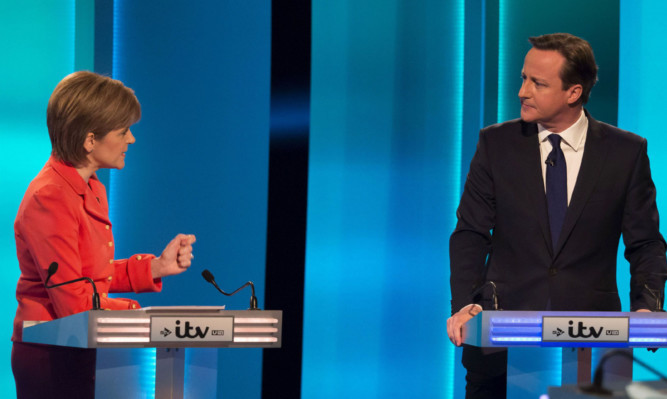
Election campaign turns nasty after controversial claims spark anger in Nationalist camp.
A Civil Service inquiry has been launched into the leaking of a UK Government memo which claimed Nicola Sturgeon privately wanted to see David Cameron remain as Prime Minister.
The First Minister reacted furiously to newspaper claims that she told the French ambassador to the UK that she preferred the Tory leader over Labour’s Ed Miliband.
Miss Sturgeon described the allegation as “100% untrue” and the French government said Miss Sturgeon did not touch on personal political preferences in the meeting.
The SNP leader yesterday accused Whitehall of “dirty tricks” and top civil servant Cabinet Secretary Sir Jeremy Heywood has ordered a probe into how the account of her conversation, thought to be produced by the Scotland Office, with the French ambassador was leaked.
Miss Sturgeon said: “The real issue is how a second hand and inaccurate account of this meeting which was not even attended by the UK government came to be written by a UK Government civil servant and then leaked to Tory-supporting newspapers at the start of a General Election campaign.
“It suggests a Whitehall system out of control a place where political dirty tricks are manufactured and leaked.
“And the Foreign Office now appears to be denying the very existence of such a document.”
The note was written by a British civil servant following a conversation with consul-general Pierre-Alain Coffinier regarding the meeting between Miss Sturgeon and ambassador Sylvie Bermann, who was on her first visit to Scotland in February.
According to a copy published on the Daily Telegraph website, it said: “Discussion appears to have focused mainly on the political situation, with the FM stating that she wouldn’t want a formal coalition with Labour; that the SNP would almost certainly have a large number of seats… that she’d rather see David Cameron remain as PM.” The note went on to say that Miss Sturgeon had said she did not think Labour leader Mr Miliband was “prime minister material”.
However the civil servant appeared to doubt whether the report accurately conveyed Ms Sturgeon’s comments, adding: “I have to admit that I’m not sure that the FM’s tongue would be quite so loose on that kind of thing in a meeting like that, so it might well be a case of something being lost in translation.”
Mr Coffinier who was present at the meeting confirmed that he had talked “in broad terms” to the UK Government’s Scotland Office about the ambassador’s visit, but denied saying that Miss Sturgeon had expressed a preference about the election outcome. “I didn’t say that,” the consul-general told Sky News. “I do not know where this comes from, because it is certainly not in my report that anyone gave any preference.”
Mr Coffinier said the conversation was conducted in English. He added: “They discussed the political situation, which is normal, but at no stage did anyone make any comment on their preference regarding the outcome of the election.”
A spokesman for Miss Bermann said in a statement: “While the Ambassador and First Minister, some time ago, discussed the political situation, Ms Sturgeon did not touch on her personal political preferences with regards to the future prime minister.”
In a letter to Miss Sturgeon, Sir Jeremy said: “You have asked me to investigate issues relating to the apparent leak of a Scotland Office memo. I can confirm that I instigated a Cabinet Office-led leak inquiry to establish how extracts from this document may have got into the public domain. Until that inquiry is complete I will not be making any further comment either on the document or the inquiry.”
A Scotland Office spokesman said: “We don’t comment on leaked documents.”

Enjoy the convenience of having The Sunday Post delivered as a digital ePaper straight to your smartphone, tablet or computer.
Subscribe for only £5.49 a month and enjoy all the benefits of the printed paper as a digital replica.
Subscribe